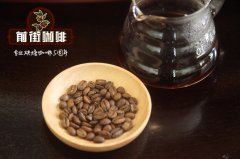The History of growing Coffee in Colombia and the famous Manor how much is a cup of Colombian coffee?

Professional coffee knowledge exchange more coffee bean information please follow the coffee workshop (Wechat official account cafe_style)
The history of coffee bean cultivation in Colombia can be traced back to the Spanish colonial era in the 16th century, and there are many theories about the history of coffee in Colombia:
One: it is said to come from the sea island of the Caribbean and from El Salvador in Central America.
Second: in 1808, a priest introduced coffee beans to Colombia for the first time from the French Antilles via Venezuela. One of them is that Colombia's first coffee seeds were imported from Venezuela through the province of Santander.
Third: the earliest records of coffee cultivation in Colombia appear in the book "The Illustrated Orinoca" written by Jose Gumilla, a Spanish missionary. He describes what he saw when he preached on both sides of the Meta River in 1730, in which he mentioned the local coffee plantation. By 1787, other missionaries had spread coffee to other parts of Colombia.
Colombia, located in the northwest of South America, is a beautiful country with a long history. Indians have lived on this land since ancient times. It was colonized by Spain in 1531 and gained independence in 1819. It was renamed in 1886 to commemorate Columbus, the discoverer of the American continent. Colombia has beautiful mountains and rivers, beautiful scenery, pleasant climate, spring all year round and fresh air. Colombia is rich in products, especially coffee, flowers, gold and emeralds are known as the "four treasures". Today, the country is the second largest coffee producer after Brazil, the world's largest exporter of Arabica coffee beans and the world's largest exporter of washed coffee beans. Colombian coffee beans are often described as silky and silky. Of all the coffees, they are the most balanced, soft, smooth and ready to drink, and they have won praise that no other coffee can match: known as "green gold".
Santa Rita Manor
Santa Rita Manor is located in the Colombian province of Antioquia, located in a micro-producing area adjacent to the Andes. This high-quality coffee is made together by nine nearby farms. The nine farms still handle the coffee in the traditional way: picking coffee cherries by hand, then washing the coffee fruits with traditional water, and drying the treated coffee beans in a scaffolding. The environment around the Andes makes this coffee-growing area rich in volcanic soil and rich in water resources.
Mirado Manor
Mirador Manor is located in the southernmost Pitalito (Pitalito) producing area of Huila (Huilan), which is famous for producing high-quality coffee. Elkin Guzman, the owner of the garden, is undoubtedly a pioneer in the coffee industry. The clever young grower uses the latest technology to improve his planting, harvesting and processing techniques. After the coffee cherries are harvested, they will be sifted in the sink and hand-selected before drying the coffee. In the first 8 days, the coffee was dried in the sun on the viaduct and stirred continuously. On the 9th day, the coffee was moved to the dryer to dry for 35 days to avoid excessive temperature affecting the flavor.
Millennium Manor
Monsalot is located in the southwest of the Colombian province of Ulla, and most of its farmers grow on a small scale, treating coffee as a staple agricultural product in exchange for cash. The New Millennium Farmers' Association (Grupo Asociativo Productores del Nuevo Milenio) was set up a few years ago to improve the quality of coffee and expect to sell raw beans at higher prices. In addition, in 2005, the United States Agency for International Development (USAID) launched the Colombian boutique coffee program in the city, introducing American boutique raw bean traders to cooperate with the Millennium Farmers' Association. They sent people to Monsalot to participate in coffee production, and knew that farmers were improving their planting techniques and producing better coffee. In the boutique coffee market, they also provided suggestions on how to position and market.
The Farmers' Association has 42 members and can produce about three containers (about 825 bags) of raw coffee beans a year. In order to improve the quality, the New Millennium Peasants' Association continues to recruit new members in Monsalot, hoping to expand the scale of production. In addition, with the assistance of USAID and American traders, they have set up a local cup testing laboratory to teach farmers the method of cup testing, hoping that farmers can pass through the cup to judge the quality of coffee, which will be helpful to coffee production.
Diamond Manor
The Diamond Manor of Colombia huila, Colombia, located in the southwest of Colombia, is one of the major coffee growing areas. Because there are famous coffee cultivation places in Huilan area, the names of small areas become brand names and circulate. Although the cultivation conditions in this area are also very good, the cultivation infrastructure of coffee cultivation farm and surrounding conditions is not well developed. It is a great pity that the raw bean drying equipment or washing processing facilities are not perfect. The coffee in Huilan area has a strong taste and heavy texture. In particular, the coffee in Huilan area can be called high-quality coffee with the aroma of nuts, chocolate and caramel and suitable acidity. And caramel and other aromas and appropriate acidity can be called high-end boutique coffee.
Columbia Coffee Bean Brand recommendation
The Colombian coffee beans baked in front street coffee are fully guaranteed in terms of brand and quality. More importantly, the performance-to-price ratio is extremely high, a box of 227 grams, the price is only 95 yuan. According to the calculation of 15 grams of powder per cup of coffee, a bag of coffee can make 15 cups of coffee, which costs only about 6 yuan per cup, which is recommended by conscience compared to the price sold in cafes for dozens of yuan a cup.
Important Notice :
前街咖啡 FrontStreet Coffee has moved to new addredd:
FrontStreet Coffee Address: 315,Donghua East Road,GuangZhou
Tel:020 38364473
- Prev

Colombian Coffee region Story Colombian Coffee Bean Price Colombian Coffee Bean recommendation
For more information on coffee beans, please follow the coffee workshop (official Wechat account cafe_style) about the planting area and harvest season of Colombian coffee beans. Colombian coffee beans are distributed along the Andes Mountains, roughly divided into northern (green), central (orange, purple) and southern (yellow) areas from south to north.
- Next

How about Colombian Rosa coffee beans? is it good? How much is the Colombian coffee bean?
For more information on coffee beans, please follow the coffee workshop (Wechat official account cafe_style) Rose Summer Geisha Geisha sounds like a geisha in Japanese, so some of them are also called geisha coffee because the tree species are taller than ordinary coffee trees and were originally planted in a small area of the manor and used as a windbreak. And the son of the manor owner, in order to participate in a year,
Related
- Does Rose Summer choose Blue, Green or Red? Detailed explanation of Rose Summer Coffee plots and Classification in Panamanian Jade Manor
- What is the difference between the origin, producing area, processing plant, cooperative and manor of coffee beans?
- How fine does the espresso powder fit? how to grind the espresso?
- Sca coffee roasting degree color card coffee roasting degree 8 roasting color values what do you mean?
- The practice of lattes: how to make lattes at home
- Introduction to Indonesian Fine Coffee beans-- Java Coffee producing area of Indonesian Arabica Coffee
- How much will the flavor of light and medium roasted rose summer be expressed? What baking level is rose summer suitable for?
- Introduction to the characteristics of washing, sun-drying or wet-planing coffee commonly used in Mantenin, Indonesia
- Price characteristics of Arabica Coffee Bean Starbucks introduction to Manning Coffee Bean Taste producing area Variety Manor
- What is the authentic Yega flavor? What are the flavor characteristics of the really excellent Yejasuffi coffee beans?

